
HPU2. Nat. Sci. Tech. Vol 03, issue 01 (2024), 3-12.
HPU2 Journal of Sciences:
Natural Sciences and Technology
journal homepage: https://sj.hpu2.edu.vn
Article type: Research article
Received date: 25-9-2023 ; Revised date: 11-12-2023 ; Accepted date: 06-02-2024
This is licensed under the CC BY-NC 4.0
3
Algebraic dependences of meromorphic mappings sharing few
moving hyperplanes with truncated multiplicity
Huong-Giang Ha*
Electric Power University, Hanoi, Vietnam
Abstract
In this article, we will prove an algebraic dependence theorem for meromorphic mappings into a complex
projective space sharing few moving hyperplanes with different truncated multiplicity. Moreover, we also
consider the weaker condition:
“ ” instead of “ ”
for some moving hyperplanes 𝑎𝑖 among the given moving hyperplanes. In order to implement this, besides
using the technique reported by S. D. Quang in (Two meromorphic mappings having the same inverse
images of some moving hyperplanes with truncated multiplicity, Rocky Mountain J. Math., vol. 52, no. 1,
pp. 263–273, 2022) we have to separate the 2n + 2 moving hyperplanes 𝑎𝑖 from the given p+1 moving
hyperplanes. After that, we count multiples of the intersection of the inverse images of the mappings f and
g sharing these moving hyperplanes. Our result is an improvement of many previous results in this topic.
Keywords: Nevanlinna theory, algebraic dependence, meromorphic mapping, hyperplanes
1. Introduction
From the “four and five values” theorems of R. Nevanlinna [1], many authors generalized the
above results to the case of meromorphic mappings sharing fixed hyperplanes in . Recently,
through the utilization of novel second main theorems for moving hyperplanes with truncated counting
functions, as introduced by authors such as M. Ru and S. Stoll [2], M. Ru and J. T. Wang [3], D. D.
Thai and S. D. Quang [4]–[6],..., many researches into this topic concerning mappings sharing moving
hyperplanes has been conducted intensively and these studies have been referenced in [7]–[18].
* Corresponding author, E-mail: gianghh@epu.edu.vn
https://doi.org/10.56764/hpu2.jos.2024.3.1.3-12

HPU2. Nat. Sci. Tech. 2024, 3(1), 3-12
https://sj.hpu2.edu.vn 4
Firstly, we recall the result of H. Fujimoto [19] in 1999. He showed that there exists a positive
integer l0 such that if two meromorphic mappings 𝑓 and 𝑔 have the same inverse images counted with
multiplicity l0 for 2𝑛 + 2 fixed hyperplanes in general position in then the mapping 𝑓 × 𝑔 is
algebraically degenerate. In 2022, S. D. Quang [12] extended above result for two mappings sharing
moving hyperplanes with different multiplicities. The purpose of this paper is to extend the result of S.
D. Quang in the case where these two mappings not only have the same inverse images counted
different multiplicities but also consider the weaker condition “ ” instead of
“ ” for some moving hyperplanes 𝑎𝑖 among the given moving hyperplanes.
Here, we denote by "𝜈𝜑,≤𝑘" the divisor of distinct zeros with multiplicities not exceeding k; if the zeros
have multiplicities which are greater than k, their multiplicities just equal to k. Namely, we prove the
following theorem.
Theorem 1.1.
Let 𝑓1, 𝑓2 be two meromorphic mappings of into . Let 𝑝 (≥ 2𝑛 + 1) and
be positive integers or ∞ and let be meromorphic mappings of into in general
position which are slow with respect to 𝑓1 and 𝑓2 with . Set
21
1
1
3 ( 2) 1
1,
2
p
ii
n q q
Ak
+
=
−
=−
222
2
1
3 ( 2) 1
1,
2
n
ii
n q q
Ak
+
=
−
=−
where . Assume that
If
min{𝐴1, 𝐴2}≥ 0 (1)
max{𝐴1, 𝐴2}> 0 (2)
then the map into is algebraically degenerate over
With the same assumption as Theorem 1.1, the following corollary is an improvement of S. D.
Quang [12] in the special case where 𝑝 = 2𝑛 + 1.
Corollary 1.2
If
22
2
1
12
3 ( 2)
n
ii
k n q q
+
=
−
then the map into is algebraically degenerate
over
2. Basic notions and auxiliary results from Nevanlinna theory
Let be a non-zero meromorphic function on . Now, we will use the standard notation from
R. Nevanlinna theory due to [9], [13]. As usual, we denote by the
counting functions of the divisors respectively, and we denote by the
characteristic function, the proximity function of , where is a meromorphic function on
. For brevity we will omit the superscript [M] if 𝑀 = ∞.

HPU2. Nat. Sci. Tech. 2024, 3(1), 3-12
https://sj.hpu2.edu.vn 5
Let be a meromorphic mapping. For arbitrarily fixed homogeneous coordinates
on we take a reduced representation 𝑓 = (𝑓
0, … , 𝑓
𝑛) which means that each 𝑓
𝑖 is a
holomorphic function on and outside the analytic set 𝐼(𝑓)= {𝑓
0= ⋯ =
𝑓
𝑛= 0} of codimension ≥ 2. Set ‖𝑓‖=(|𝑓
0|2+ ⋯ + |𝑓
𝑛|2)1 2
⁄.
Throughout this paper, by the notation “|| P” we mean the assertion P holds for all
excluding a Borel subset E of the interval with .
Proposition 2.1
Let 𝑓 be a nonzero meromorphic function on . Then
Let (𝑞 ≥ 𝑛 + 1) be 𝑞 meromorphic mappings of into the dual space with
reduced representations 𝑎𝑖=(𝑎𝑖0, … , 𝑎𝑖𝑛) (1 ≤ 𝑖 ≤ 𝑞) We say that are located in general
position if for any . Let be the field of all meromorphic functions
on . Denote by the smallest subfield which contains and all .
Throughout this paper, if without any notification, the notation always stands for .
We call each meromorphic mapping of into a moving hyperplane in . A
moving hyperplane a in is said to be “slow” (with respect to 𝑓) if ||
Let 𝑁 be a positive integer and let 𝑉 be a projective subvariety of . Take a homogeneous
coordinates of . Let F be a meromorphic mapping of into 𝑉 with a
representation 𝐹 = (𝐹0, … , 𝐹
𝑛).
Definition 2.2
The meromorphic mapping 𝐹 is said to be algebraically degenerate over a subfield of if
there exists a homogeneous polynomial with the form
where 𝑑 is an integer, and for , such
that
(i) on ,
(ii) there with on 𝑉.
Let 𝑓 and 𝑔 be two meromorphic mappings of into with representations 𝑓 =
(𝑓
0, … , 𝑓
𝑛) and 𝑔 = (𝑔0, … , 𝑔𝑛).
We consider as a projective subvariety of by Segre embedding.
Then the map into is algebraically degenerate over a subfield of if
there exists a nontrivial polynomial

HPU2. Nat. Sci. Tech. 2024, 3(1), 3-12
https://sj.hpu2.edu.vn 6
where 𝑑, 𝑑′ are positive integers, , such that
Let be a meromorphic mapping. Suppose that 𝑎 have reduced representation
(𝑎0, … , 𝑎𝑛). We put . The definition of this function depends on the choices of reduced
representation 𝑎, but its divisor does not depend on that. Similarly, we define the proximity
function and the first main theorem for moving hyperplanes (see [20]) as follows.
Proposition 2.3 (see [5], Theorem 1.3).
Let be a meromorphic mapping. Let be
meromorphic mappings of into in the general position such that , where
. Then we have
Proposition 2.4 (see [3]).
Let 𝑓 = (𝑓
0, … , 𝑓
𝑛) be a reduced representation of a meromorphic mapping 𝑓 of into .
Assume that is a holomorphic function with . If for all
then
Proposition 2.5 (see [20], Theorem 5.2.29).
Let 𝑓 be a nonzero meromorphic function on with a reduced representation 𝑓 = (𝑓
0, … , 𝑓
𝑛).
Suppose that , then
3. Proof of Theorem 1.1
Let be 2𝑛 + 1 hyperplanes of in general position given by
We consider the rational map as follows:
For , we define the value
by

HPU2. Nat. Sci. Tech. 2024, 3(1), 3-12
https://sj.hpu2.edu.vn 7
Lemma 3.1 (see [19], Proposition 5.9).
The map is a birational map of to . Let be 2𝑛 + 1 moving
hyperplanes of in general position with reduced representations
𝑎𝑖=(𝑎𝑖0, … , 𝑎𝑖𝑛) (1 ≤ 𝑖 ≤ 2𝑛 + 1)
Let 𝑓1 and 𝑓2 be two meromorphic mappings of into with reduced representations
𝑓1=(𝑓
0
1, … , 𝑓
𝑛
1) 𝑎𝑛𝑑 𝑓2=(𝑓
0
2, … , 𝑓
𝑛
2)
Define and for each subset I of {1,..., 2n + 1}. Set
Lemma 3.2 (see [15]).
If there exist functions , not all zero, such that
then the map into is algebraically degenerate over .
Lemma 3.3 (see [15]).
Let 𝑓 be a meromorphic mapping of into and let be moving hyperplanes of
in general position. Then for each regular point z0 of the analytic subset
with we have
where 𝐼(𝑓) denotes the indeterminacy set of 𝑓 and is the matrix .
Proof of Theorem 1.1.
By changing the homogeneous coordinates of if necessary, we may assume that for
all 1 ≤ 𝑖 ≤ 𝑝 + 1. We set ,
We suppose contrarily that the map is algebraically non-degenerate over We
set .

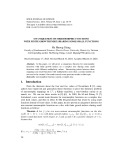
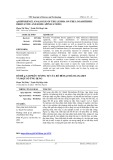
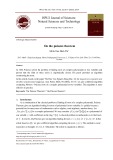
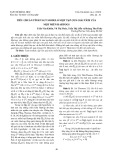
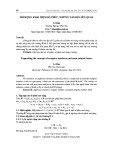
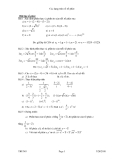

![Mã hóa mức vật lý: Phần [Thông tin chi tiết/Hướng dẫn/Tổng quan]](https://cdn.tailieu.vn/images/document/thumbnail/2011/20110425/magiethitham/135x160/kythuattruyensolieu_pdf0118_0701.jpg)
















![Quyển ghi Xác suất và Thống kê [chuẩn nhất]](https://cdn.tailieu.vn/images/document/thumbnail/2025/20251030/anh26012006/135x160/68811762164229.jpg)
